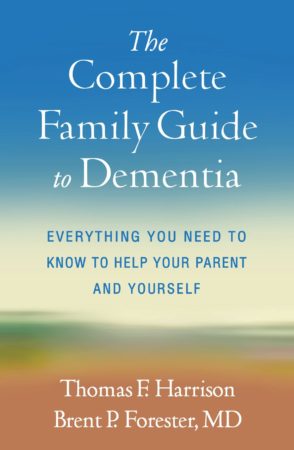Care smarter, not harder for people with dementia. Authors, Thomas F. Harrison and Brent P. Forester, MD compassionately guide caregivers with sensitivity, understanding, and empathy via their new book, The Complete Family Guide to Dementia.
A Nuanced Compassionate Guide
The Complete Guide… delivers on its promise to be different than books written by medical professionals or caregivers. This book focuses on the caregiver, who is caring for a person with dementia. It is divided into four sections featuring 26-short chapters that compassionately describe with nuanced sensitivity what families experience while trying to care for Mom or Dad living with dementia.
It’s as if the authors view our loved ones as their own family, while they address caregivers’ daily reality of the struggles, joys, and emotions.
While the first two sections build on an understanding of dementia and one’s changed relationship with a parent; the third section remains the heart of this book.
Section 3 titled, “Caring Smarter, Not Harder,” features eleven chapters. Four are worth referencing again and again; especially, during challenging caregiving moments.
How to Communicate with a Person with Dementia
The first of these four chapters, describes how to communicate with a parent (or anyone) with dementia. It prioritizes empathy with genuine understanding. For example, the importance of setting context to help a loved one make sense of the conversation and situation. The authors make this clear with a meaningful and “novel” analogy. Imagine starting in the middle of a new novel. While you understand the words, you lack context for the setting, the storyline, the people and their relationships. Soon, you lose interest because you lack contextual understanding. Similarly, people with Alzheimer’s will grow frustrated because they cannot recall how they know the friendly familiar faces in front of them.
This chapter also includes one worthwhile perspective on the ongoing debate: Should we tell our loved one with dementia about an upcoming appointment? (The authors say, “No” and explain why.)
Among other tips in this chapter, is how to communicate to reduce agitation. For example, say words that let Mom or Dad know what they can do. Instead of, “No, you cannot go outside in your pajamas,” try, “Yes, let’s go outside, but it’s cold, so let’s wear our sweaters.”
The Caregiver’s Voice advocates this approach as it uplifts and saves time. Read: Give the Gift of Positive Language.
Problem Behaviors—Cause, Reducing, Handling in Real Time
Toward the end of this “Caring Smarter” section are three chapters that address the causes, how to reduce, and handle problem behaviors when they occur. While some in the profession prefer to use terminology that does not label behavior as disruptive or problematic, the authors approach the topic with clarity and even face-saving dignity for the person with dementia.
Problem behaviors may be caused by stress, medications, or depression. Yet, most often these behaviors are due to the person with dementia being confused, frustrated, suspicious, or afraid and wanting to escape. People can act out because their needs are not being met or they’re experiencing delusions. The important point is to try and understand. The authors give this example: If you forget to buy eggs, that’s not as big of an issue as removing eggs from the refrigerator and not knowing what to do with them.
In this section, the authors also offer an accurate description of where home is. When a parent says, “I want to go home.” It’s really quite simple and worth reading.
Two Items Worth Noting
Use of the label “dementia sufferers.”
The authors use “dementia sufferers” throughout the book. While families do suffer, the reality is people with dementia are trying to live with this incurable disease. Such a label only promotes the stigma of dementia.
Discourage use of conservatorship or guardianship.
Despite the upfront cost, it is worthwhile to seek court oversight in the form of a conservatorship or guardianship. Doing so will prevent future and costlier lawsuits when families cannot resolve dissenting opinions on Mom or Dad’s care. Furthermore, such legal measures are not as constricting as the authors note.
Additional Highlights
There are more areas worth reading in The Complete Family Guide to Dementia.
- The description of other causes of dementia, beyond Alzheimer’s, is the clearest yet. The authors also cite an interesting autopsy study revealing that most people’s brains show evidence of more than one cause of dementia.
- A review of the current medications to treat dementia symptoms and the potential harm caused if the wrong medication is given without a proper diagnosis.
- The respectful yet powerful coverage of delusions. Tips on dealing with harmful delusions and why they may persist.
- Detailed and clear description of the three documents we all should have in the event of an emergency or unforeseen outcome. These include Power of Attorney; Health Care and Living Will; Will and/or Living Trust. This chapter also covers the pros and cons of naming one versus two Attorney(s) in Fact; where to place your Health document so it does the most good; and naming beneficiaries when accounts may be titled in the person’s name (instead of the trust).
The fourth and final part of the book covers the late stages of dementia including placement in a care home. This phase will change your relationship with your parent, again. The authors recommend, for example, if your loved one lives close enough, visit more frequently for shorter periods of time.
Dr. Forester and Thomas Harrison’s Guide is a compassionate and empathic walk beside you. If you care enough, share The Complete Family Guide to Dementia with a caregiver who could use a bit of empathy. The content will inspire, uplift, and inform while preserving dignity. Or if you’re a caregiver, ask a family member or friend to order you a copy.
The Caregiver’s Voice publishes reviews of current-year or even forthcoming books. The Complete Family Guide to Dementia, arrived in fall of 2022.








